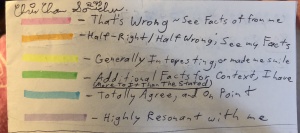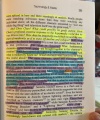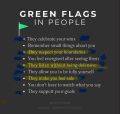Difference between revisions of "Chris and reading"
| (5 intermediate revisions by the same user not shown) | |||
| Line 1: | Line 1: | ||
{{Incomplete|summary, [[:Category:Books|books list]]}} | |||
Anyone who wants to be a good writer must be well-read. It's one of the most natural ways to become acquainted with good style, the elements of a plot, and correct spelling. Chris's [[Chris and his ego|ego]] is so inflated that he thinks he can produce something [[Honor roll|brilliant]] with no effort whatsoever. While in school, the only books Chris read voluntarily are paperback ''Goosebumps'' and ''Fear Street'' novels by [[R.L. Stine]] which are notable only for their sheer mediocrity. Chris read these books, which were written for elementary schoolers, well into high school. | |||
Before Stine, Chris enjoyed reading ''Berenstain Bears'',<ref>[[Warhol Tweets#Chris larps as his younger self]]</ref> ironically claiming that ''The Bad Habit'' was his favourite book as a child.<ref>[[Jackie E-mails 2#More questionnaire, Game Place is brewing]]</ref> Given that the books are simplistic morality tales about talking animals in which problems come out of thin air and are easily resolved by the final pages, it's not hard to see how they appealed to Chris (let alone possibly influenced [[Chris and reality|his childlike worldview]] and literary style). | |||
In terms of the readings he was assigned at [[Manchester High School]], Chris retained only a superficial understanding of them. During the [[Father Call]], Chris said that he read ''{{w|To Kill a Mockingbird}}'' a mere month prior, which in all likelihood he only mentioned because it was assigned in high school. This was almost instantly proven false when he confused it with ''[[wikipedia:Of Mice and Men|Of Mice and Men]]'', another high school assignment. The [[Manchester High Leaks|essay]] he wrote about a selection from [[wikipedia:Geoffrey Chaucer|Geoffrey Chaucer]]'s ''[[wikipedia:The Canterbury Tales|Canterbury Tales]]'' earned only a 69%. | |||
==Use of highlighters== | ==Use of highlighters== | ||
{{quote|Also, so y’all know, I have a rainbow of highlighters, each specified within the false-true range, and then some. Pay Attention.|Chris, June 2021<ref name=june21>[[June 2021 social media posts#Andy Warhol Technology chapter]]</ref>}} | {{quote|Also, so y’all know, I have a [[rainbow]] of highlighters, each specified within the false-true range, and then some. Pay Attention.|Chris, June 2021<ref name=june21>[[June 2021 social media posts#Andy Warhol Technology chapter]]</ref>}} | ||
[[File:June29BookPhoto3.jpg|thumb|200|Chris's chart explaining his highlight notation]] | [[File:June29BookPhoto3.jpg|thumb|200|Chris's chart explaining his highlight notation]] | ||
A '''highlighter''' is a writing tool for specially noting text. Chris has a system for highlighting, demonstrated on at least | A '''highlighter''' is a writing tool for specially noting text. Chris has a system for highlighting, demonstrated on at least three occasions. | ||
When reading ''[[Warhol / Chris Chan]]'', Chris highlighted selected portions of the text in various colors. He explained his methods in a Twitter post:<ref name=june21></ref> | When reading ''[[Warhol / Chris Chan]]'', Chris highlighted selected portions of the text in various colors. He explained his methods in a Twitter post:<ref name=june21></ref> | ||
| Line 30: | Line 36: | ||
{{References}} | {{References}} | ||
{{Chris and}} | |||
[[Category:Books]] | |||
Revision as of 11:01, 20 June 2024
Anyone who wants to be a good writer must be well-read. It's one of the most natural ways to become acquainted with good style, the elements of a plot, and correct spelling. Chris's ego is so inflated that he thinks he can produce something brilliant with no effort whatsoever. While in school, the only books Chris read voluntarily are paperback Goosebumps and Fear Street novels by R.L. Stine which are notable only for their sheer mediocrity. Chris read these books, which were written for elementary schoolers, well into high school.
Before Stine, Chris enjoyed reading Berenstain Bears,[1] ironically claiming that The Bad Habit was his favourite book as a child.[2] Given that the books are simplistic morality tales about talking animals in which problems come out of thin air and are easily resolved by the final pages, it's not hard to see how they appealed to Chris (let alone possibly influenced his childlike worldview and literary style).
In terms of the readings he was assigned at Manchester High School, Chris retained only a superficial understanding of them. During the Father Call, Chris said that he read To Kill a Mockingbird a mere month prior, which in all likelihood he only mentioned because it was assigned in high school. This was almost instantly proven false when he confused it with Of Mice and Men, another high school assignment. The essay he wrote about a selection from Geoffrey Chaucer's Canterbury Tales earned only a 69%.
Use of highlighters
| “ | Also, so y’all know, I have a rainbow of highlighters, each specified within the false-true range, and then some. Pay Attention. | ” |
| Chris, June 2021[3] | ||
A highlighter is a writing tool for specially noting text. Chris has a system for highlighting, demonstrated on at least three occasions.
When reading Warhol / Chris Chan, Chris highlighted selected portions of the text in various colors. He explained his methods in a Twitter post:[3]
- Pink - That's Wrong ~ See Facts of from me
- Orange - Half-Right / Half Wrong, See my Facts
- Yellow - Generally Interesting, or made me smile
- Green - Additional Facts for Context, I have (More To It Than The Stated)
- Blue - Totally Agree, and on Point
- Purple - Highly Resonant with me
Highlighted text from Warhol / Chris Chan
References
| Chris and... |
|
Body: Drugs • Fashion • Gender • Health • Nutrition • Sex Psyche: Coping • Manipulation • Mental healthcare • Nostalgia • Reality Personality: Anger • Ego • Hypocrisy • Kindness • Negligence • Personality • Remorse • Stress Expression: Art • Censorship • English • Language • Music • Oratory • Spanish • Writing Society: Contests • Death • The Law • Politics • Race • Reading • Religion • Sexuality • Socialization • Sports Business: Brand loyalty • Business • Copyright • Money • Negotiation • Work Technology: Cameras • Electronics • The Internet • Science • Television • Video Games |





